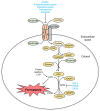Ferroptosis, Metabolic Rewiring, and Endometrial Cancer
- PMID: 38203246
- PMCID: PMC10778781
- DOI: 10.3390/ijms25010075
Ferroptosis, Metabolic Rewiring, and Endometrial Cancer
Abstract
Ferroptosis is a newly discovered form of regulated cell death. The main feature of ferroptosis is excessive membrane lipid peroxidation caused by iron-mediated chemical and enzymatic reactions. In normal cells, harmful lipid peroxides are neutralized by glutathione peroxidase 4 (GPX4). When GPX4 is inhibited, ferroptosis occurs. In mammalian cells, ferroptosis serves as a tumor suppression mechanism. Not surprisingly, in recent years, ferroptosis induction has gained attention as a potential anticancer strategy, alone or in combination with other conventional therapies. However, sensitivity to ferroptosis inducers depends on the metabolic state of the cell. Endometrial cancer (EC) is the sixth most common cancer in the world, with more than 66,000 new cases diagnosed every year. Out of all gynecological cancers, carcinogenesis of EC is mostly dependent on metabolic abnormalities. Changes in the uptake and catabolism of iron, lipids, glucose, and glutamine affect the redox capacity of EC cells and, consequently, their sensitivity to ferroptosis-inducing agents. In addition to this, in EC cells, ferroptosis-related genes are usually mutated and overexpressed, which makes ferroptosis a promising target for EC prediction, diagnosis, and therapy. However, for a successful application of ferroptosis, the connection between metabolic rewiring and ferroptosis in EC needs to be deciphered, which is the focus of this review.
Keywords: endometrial cancer; ferroptosis; metabolism; resistance.
Conflict of interest statement
The author declares no conflict of interest.
Figures






Similar articles
-
SENP5 promotes endometrial cancer cell growth by regulating β-catenin deSUMOylation to enhance GPX4-resistance to ferroptosis.Eur J Med Res. 2025 May 24;30(1):411. doi: 10.1186/s40001-025-02662-9. Eur J Med Res. 2025. PMID: 40410883 Free PMC article.
-
Targeting GPX4 in human cancer: Implications of ferroptosis induction for tackling cancer resilience.Cancer Lett. 2023 Apr 10;559:216119. doi: 10.1016/j.canlet.2023.216119. Epub 2023 Mar 8. Cancer Lett. 2023. PMID: 36893895 Review.
-
Mechanisms and regulations of ferroptosis.Front Immunol. 2023 Oct 6;14:1269451. doi: 10.3389/fimmu.2023.1269451. eCollection 2023. Front Immunol. 2023. PMID: 37868994 Free PMC article. Review.
-
Dauricine alleviated secondary brain injury after intracerebral hemorrhage by upregulating GPX4 expression and inhibiting ferroptosis of nerve cells.Eur J Pharmacol. 2022 Jan 5;914:174461. doi: 10.1016/j.ejphar.2021.174461. Epub 2021 Aug 29. Eur J Pharmacol. 2022. PMID: 34469757
-
GPX4 at the Crossroads of Lipid Homeostasis and Ferroptosis.Proteomics. 2019 Sep;19(18):e1800311. doi: 10.1002/pmic.201800311. Epub 2019 May 31. Proteomics. 2019. PMID: 30888116 Review.
Cited by
-
METTL5 regulates SEPHS2-mediated selenoprotein synthesis to promote multiple myeloma survival and progression.Cell Death Dis. 2025 Aug 2;16(1):585. doi: 10.1038/s41419-025-07904-6. Cell Death Dis. 2025. PMID: 40750759 Free PMC article.
-
Identification of clusters related to programmed cell death and potential prognostic biomarkers for immunotherapy response in endometrial cancer.Sci Rep. 2025 Jul 1;15(1):22165. doi: 10.1038/s41598-025-06672-9. Sci Rep. 2025. PMID: 40595063 Free PMC article.
-
Immune cell infiltration as a prognostic factor in endometrial cancer: a meta-analysis.Am J Cancer Res. 2025 Mar 15;15(3):1335-1345. doi: 10.62347/BXZM8857. eCollection 2025. Am J Cancer Res. 2025. PMID: 40226477 Free PMC article.
-
Integrated Identification and Immunotherapy Response Analysis of the Prognostic Signature Associated With m6A, Cuproptosis-Related, Ferroptosis-Related lncRNA in Endometrial Cancer.Cancer Rep (Hoboken). 2024 Sep;7(9):e70009. doi: 10.1002/cnr2.70009. Cancer Rep (Hoboken). 2024. PMID: 39324703 Free PMC article.
-
Establishment of a prognostic signature and immune infiltration characteristics for uterine corpus endometrial carcinoma based on a disulfidptosis/ferroptosis-associated signature.Front Immunol. 2025 Jan 27;16:1492541. doi: 10.3389/fimmu.2025.1492541. eCollection 2025. Front Immunol. 2025. PMID: 39931061 Free PMC article.
References
Publication types
MeSH terms
Substances
Grants and funding
LinkOut - more resources
Full Text Sources

